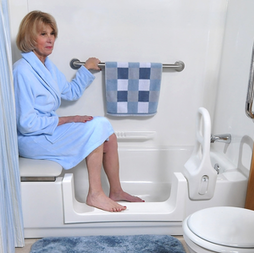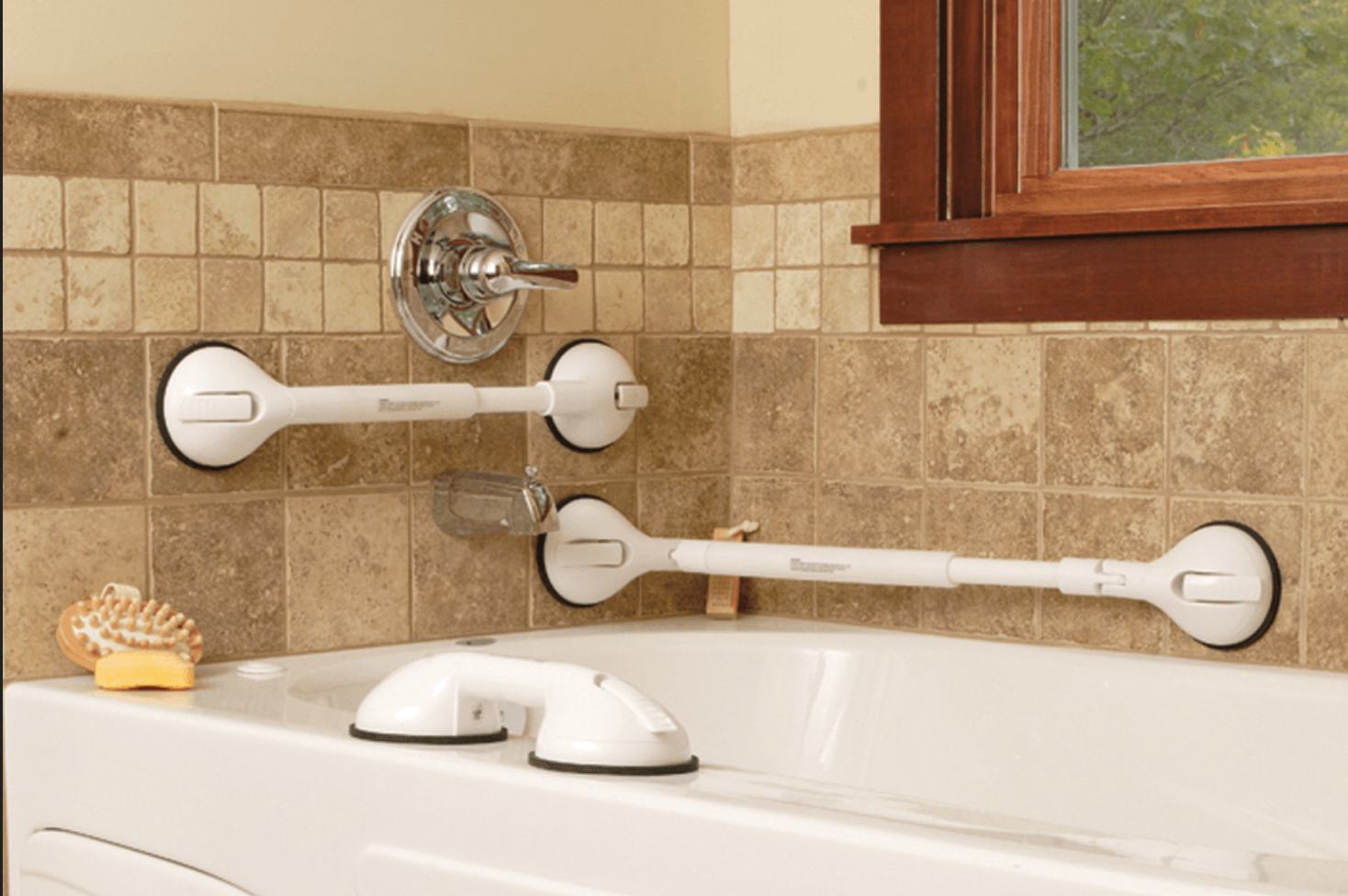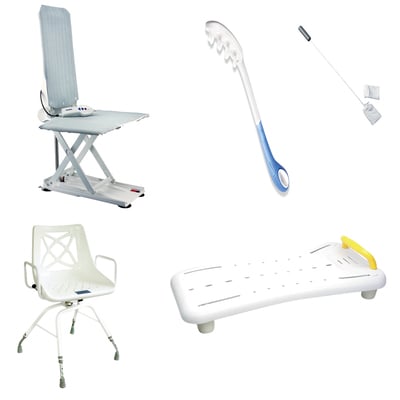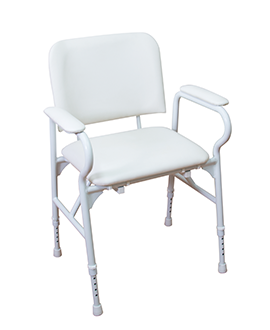Buyers guide to safe showering
Safe Showering and Bathing Guide
A guide to the improving mobility and staying safe in the bathroom at home
Being able to go into the bathroom, close the door and take care of our own cleaning rituals in private is something many of us take for granted. So when we experience a decrease in mobility  due to aging or health issues, it can be difficult to admit we’re struggling or relinquish that independence.
due to aging or health issues, it can be difficult to admit we’re struggling or relinquish that independence.
However, there is plenty of assistance available to help you or a parent stay safe while showering or bathing at home. In this guide you’ll find tips and guidance to mitigate the risk of slips and falls in the bathroom, along with information on getting help if you need it.
Being able to go into the bathroom, close the door and take care of our own cleaning rituals in private is something many of us take for granted. So when we experience a decrease in mobility due to aging or health issues, it can be difficult to admit we’re struggling or relinquish that independence.
However, there is plenty of assistance available to help you or a parent stay safe while showering or bathing at home. In this guide you’ll find tips and guidance to mitigate the risk of slips and falls in the bathroom, along with information on getting help if you need it.
The importance of safe showering and bathing

Showering and bathing isn’t just about personal hygiene when you get older. Laying in a warm bath can provide relief from muscle and joint pain and can also just be a way to destress. Likewise, a refreshing shower can help to invigorate the body and provide a sense of freshness.
However, bathing and showering can also bring with it a lot of anxiety. A fear of falling, dizziness or inability to manage things without assistance can make this normally pleasant ritual something to be avoided.
Meanwhile, the bathroom is the second most common area around the home where the elderly experience a fall resulting in injury. And not only is falling more likely when you are are aged 65 or older, the risk of injury – both minor and major – also increases. So it’s important to take steps to make the bathroom as safe as possible to reduce this risk and make bathing a relaxing and comfortable experience.
Safety in the bathroom
Creating a safe bathroom environment is essential to making those daily tasks as pleasant as possible.
Bathroom safety is not just about using mobility aids; it’s also about making the experience positive for you or your parent. Some things you can do to make bathing and showering safe are:
- mopping up excess water and other spills immediately with a cloth to avoid slips
- setting the hot water temperature to 40C to avoid scalds
- making sure the bathroom is well lit, especially at night
- placing shampoo, soap and other toiletries where they can be reached easily
- keeping the floor clear of clothes, towels, bathroom scales and other items
- establishing a routine for showering or bathing, and avoiding difficult tasks while tired, rushed or stressed
- eating a balanced diet and drinking plenty of fluids to prevent falls caused by fatigue and dehydration
- maintaining a healthy and active lifestyle, with plenty of movement and exercise to keep your muscles strong and flexible
- making sure any clothing you wear in the bathroom isn’t too long, which could cause a trip hazard
Specific modifications, additions and accessories can also be used to make showering and bathing safer and more comfortable.
Bathroom aids and accessories
Some of the modifications and aids you may get for the bathroom include the following,
Grab bars and handrails
Grab bars and handrails can be installed near the shower and bath to provide extra support when getting in and out. These sturdy bars give you something to hold onto and can help provide support and prevent a fall.
Grab bars are suited to people with good upper body strength who simply need another point of  contact when moving or stepping over the bath. Before installing, observe how you naturally move from the shower or bath and note the points where you may reach for a wall or ledge for support.
contact when moving or stepping over the bath. Before installing, observe how you naturally move from the shower or bath and note the points where you may reach for a wall or ledge for support.
Support bars and rails can be either bolted to the wall or attached with suction cups. Bolted on rails should be attached with the assistance of a professional as they need to be drilled into the wall stud for support.
Suction cup grab rails are ideal where you cannot install bolts – such as the edge of a bath – or if you want to avoid drilling into tile or walls. The durable, commercial-grade suction cup is easy to install and remove without tools, yet will provide adequate support for most adults. They come in standard, telescoping and pivot grip, enabling them to be installed in tight corners.
Shower chairs
A shower chair can provide stability if you have difficulty balancing in the shower or prefer not to stand for long periods. Due to their lightweight, compact design, they can be placed in the shower when needed, then removed when other family members are showering.
They are available as either a traditional chair with a backrest or a bench style seat with handles at either end. If you have uneven surface in the shower look for a chair with adjustable legs that can be set at different heights and ensure the chair has rubber tipped feet to prevent sliding.
Bath chair or bench
A bath chair or bench makes getting into and out of the bath easier, providing assistance whether you have a carer or not. Bath chairs work by allowing you to sit down at a regular 90 degree angle outside the bath before swinging your legs over the edge. While you won’t actually be able to lower into the bath, they can be used with a hand held shower head for all over wash.
Non-slip bath mats
These rubber mats prevent slips in the bath or shower by providing a textured surface to stand or sit on. They attach using moulded suction cups on the underside and have a non-slip rubber surface that provides grip. Bath mats are available in various sizes and are a low-cost option.
Hand held shower
A hand-held shower is designed to be held in one hand and makes it easier to clean all areas of the body, even when seated. It attaches to the existing tap in the bath or sink and the gentle flow is ideal for sensitive skin. It’s also handy for washing hair in the sink.
Assistance with showering and bathing
Even with the use of bathroom aids, there may come a time when your loved one or parent will be unable to bathe without assistance. This may be due to mobility issues, dizziness or a loss of cognitive ability.
It’s important that you allow them to guide you on the assistance that they need, especially if they are still able to undertake most tasks without assistance. Create a dialogue by voicing your concerns, then listen to them and allow them to present potential solutions.
Your occupational therapist can help you understand the different ways you can help with bathing and showering tasks.
They’ll be able to show you ways to transfer in and out of the shower or bath and help with washing and dressing while maintaining their privacy.
Bathing and showering can bring up very real fears, especially if there have been incidents of slips or falls previously. If you’re helping a loved one to bathe, try to make the experience as relaxing as possible. Arrange to do it at a time when you’re not rushed and are feeling awake – this may be in the morning or late afternoon, depending on both of your schedules.
Take things slow and explain what you’re going to do before you take each action. Keep the bathroom warm and have plenty of towels available.
Getting help at home
My Aged Care is a government program that can help you access support at home to carry out daily tasks. A range of services are offered, all designed to assist you to maintain your independence and improve your wellbeing.
Through My Aged Care you can arrange to have someone come to your home to help with bathing, showering, dressing and toileting, along with other services.
The first step in getting help is by calling My Aged Care on 1800 200 422. You’ll be asked questions about your needs and circumstances so My Aged Care staff can refer you to the right aged care services. From there you’ll have an assessment, before being provided with a care plan that outlines the services you’ll receive.
For more information visit the My Aged Care website https://www.myagedcare.gov.au














































































